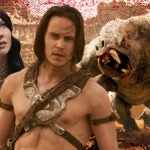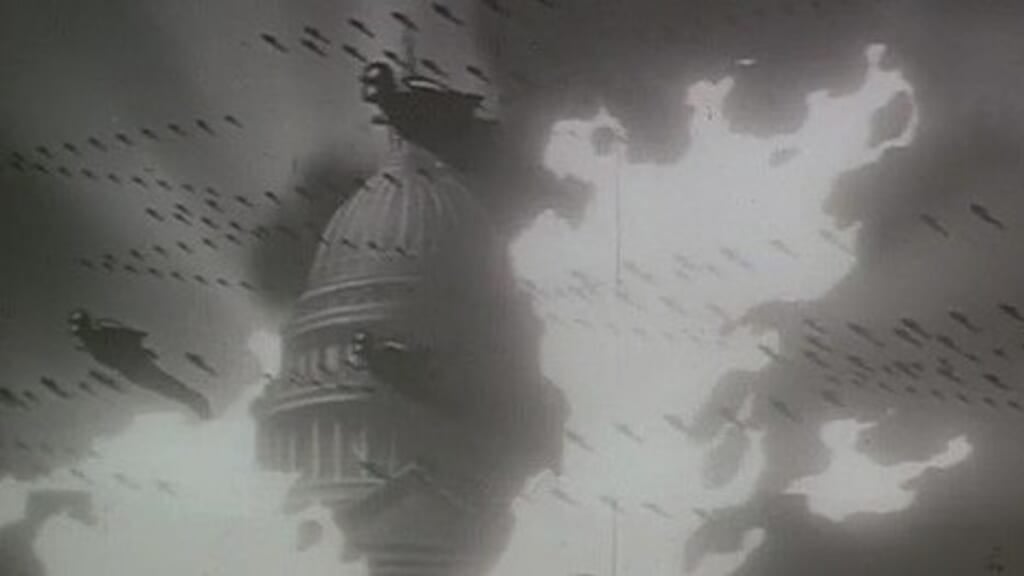How the Animated Nazi Sequence Got here to Be

There’s a scene in “The Rocketeer,” Disney’s large finances would-be blockbuster from the summer time of 1991, that ranks among the many most profoundly unusual and transfixing moments within the studio’s storied historical past.
The scene, which takes place in 1938, unfolds proper earlier than the film’s large, fiery climax at L.A.’s Griffith Observatory. Our hero, L.A. stunt pilot-turned-makeshift-superhero Cliff Secord (Billy Campbell) is within the workplace of Howard Hughes (a superbly forged Terry O’Quinn). Hughes, it seems, is the inventor of an experimental rocket pack that Secord has occurred upon and utilized in a sequence of thrilling motion sequences. The FBI is there too. Hughes needs his rocket again, stressing how probably harmful it’s, particularly if it fell into the fallacious arms. Secord needs to maintain it.
To underline his level, Hughes exhibits Secord a movie. “Preserve watching, child. It value a person’s life to get this out of Germany,” Hughes remarks. It’s an animated propaganda movie, exhibiting the Nazi plan for the rocket pack. Fascism spreads throughout the globe. “Rocket-borne assault troops superior on Washington, D.C.,” reads the official novelization by Peter David. “Because the Capitol burned, searing flames leapt as much as engulf a proud federal eagle. The image melted like wax, after which re-formed right into a Nazi eagle.”
This unusual passage in Disney’s historical past has lengthy been unexplored. TheWrap spoke to the filmmakers behind the movie and the animators of this Nazi sequence about how an animated interlude that includes flying stormtroopers was being drawn similtaneously Walt Disney Animation was redefining itself as a prestigious (and really family-friendly) powerhouse.
“I went over and met with Joe (Johnston, the director) and he simply defined to me what the sequence was, only a brief little one-minute, two-minute sort factor to inform this little story. And I believe that’s the way it received began,” animator Mark Dindal instructed TheWrap.
The truth that the carnage is animated in velvety black and white makes the scene even weirder and extra disturbing. Even for those who’ve solely seen the movie as soon as, perhaps within the theater as a child or when it aired as a part of “The Magical World of Disney” in 1994 or whereas toggling by means of Disney+ searching for one thing to look at, chances are high you continue to bear in mind this second. It’s that indelible. “The Rocketeer’s” animated Nazi propaganda sequence additionally stands, in a film usually beset by company interference, budgetary cutbacks and artistic second-guessing, as an uncompromised inventive triumph. All 45 seconds of it.
A Bumpy Takeoff
“The Rocketeer” started life in 1982 as an unbiased comedian by author and illustrator Dave Stevens. First relegated as a “backup title” within the final pages of “Starslayer” for Pacific Comics, the sequence had a small however devoted cult following. Stevens was keenly thinking about aviation, pulp journey tales, and pin-up women, all of which gelled magnificently within the pages of “The Rocketeer.” Characters stated stuff like “I believe yer loony for keepin’ this factor” and in contrast to within the last film, Cliff’s girlfriend wasn’t an cute ingenue attempting to make it in Hollywood however a sultry pinup woman who takes nude photographs and was clearly an amalgamation of kitsch icon Betty Web page and Stevens’ spouse on the time, actress Charlene Brinkman (also called Brinke Stevens, star of exploitation films like “Sorority Babes within the Slimeball Bowl-O-Rama”).
In 1985, whereas trying to find potential materials to both adapt or rip off at Hollywood comedian store Golden Apple, screenwriters Danny Bilson and Paul DeMeo (who handed away in 2018) learn and fell in love with “The Rocketeer.” On the time, Bilson and DeMeo had been identified for his or her high-concept, low-budget screenplays for films like “Eliminators” and “Area,” produced on a budget for schlock pioneer Charles Band. “The Rocketeer” was proper up their alley. That they had came upon that Steve Miner, the director of “Home” (and later the considerably “Rocketeer”-ish “Ceaselessly Younger”) had optioned the e-book however that the choice was about to run out.
They organized for Stevens to see a tough reduce of their upcoming movie “Zone Troopers,” a captivating sci-fi movie about World Conflict II troopers that occur upon an alien spaceship that shares a lot of its DNA with “The Rocketeer.” (Bilson directed, DeMeo produced they usually each wrote the display screen.) Stevens was impressed by “Zone Troopers” and Bilson and DeMeo’s thought to by some means insert Rondo Hatton, an acromegalic actor from the ’30s and ’40s whose exaggerated facial options led to a memorable function as “The Creeper” in a number of horror movies, into the “Rocketeer” narrative as a serious villain. “We had been on the identical web page on previous films, B-movies from the ’40s,” Bilson stated. Stevens agreed to work with the writers to carry “The Rocketeer” to the large display screen and didn’t even cost them a payment to choice the property. “There was no choice cash exchanged,” Bilson stated. It was all for the love of “The Rocketeer.”
The efforts to rework “The Rocketeer” from cult comics curiosity to large display screen hero in the end took for much longer than anyone anticipated. Initially Bilson, DeMeo and Stevens labored with director William Expensive on the difference (Bilson remembers visiting the set of his Bigfoot comedy “Harry and the Hendersons” whereas engaged on the script). Expensive has a “story by” credit score on the ultimate movie.

When Walt Disney Photos bought the venture for its extra mature Touchstone Photos label, executives handed it to Joe Johnston. Johnston was already a celebrated storyboard artist and results technician; he had designed Boba Fett for “The Empire Strikes Again,” labored extensively with George Lucas’ Industrial Mild & Magic and had the technical chops to wrangle such a probably cumbersome manufacturing. He was additionally coming off of directing “Honey, I Shrunk the Childs” for Disney, the place he served as a last-minute substitute for unique director Stuart Gordon. “Honey, I Shrunk the Children” was, on the time, a uncommon live-action Disney field workplace success. “They needed to wager on Joe. That’s what I bear in mind,” Bilson stated. “It felt like a enterprise factor.”
Johnston, an aviation nut, needed to make a film of his personal from the bottom up. By his personal estimation, Johnston “threw out” the Expensive model of the script and started anew. “I instructed Stevens earlier than we began that I needed it to appear to be a hand-tinted postcard from ’30s Los Angeles,” Johnston remembered. And in Bilson and DeMeo, he had the proper companions.
Relating to the animated sequence, Johnston can’t bear in mind if it was part of the preliminary Bilson and DeMeo script. (Within the November 1991 difficulty of visible results commerce journal Cinefex, Johnston merely states that it was “within the script.”) Bilson can’t bear in mind both. “You’ve hit me with a tricky one,” Bilson stated. “And there have been a variety of drafts.”
The screenplay for “The Rocketeer” was labored on by a number of high-profile screenwriters who got here aboard, contributed a draft after which moved on, a bunch journalist Peter Bart referred to on the time as fender-and-body boys. (Amongst them: “Stakeout” screenwriter and Disney favourite Jim Kouf, who in line with Bilson supplied the “large gopher” joke, and a pre-“Shawshank Redemption” Frank Darabont, who was an artwork director years earlier than on Bilson and DeMeo’s cult 1984 characteristic “Trancers.”) “They weren’t as true to Dave Stevens’ comedian,” Johnston stated of the opposite drafts. Bilson and DeMeo had been summoned once more. “In contrast to a variety of films at Disney on the time, we had been introduced again on after we had been rewritten a few occasions. We had been the primary and final writers on ‘The Rocketeer’,” Bilson stated.

One factor’s for certain – the animated propaganda movie sequence wasn’t within the unique comedian e-book, as within the first few points characters assume that Howard Hughes constructed the rocket pack but it surely’s later prompt that the precise creator was pulp hero Doc Savage, the “Man of Bronze” primarily written by Lester Dent, who first appeared in 1933 and was tailored right into a marginal, George Pal-produced characteristic in 1975.
By all accounts, the manufacturing of “The Rocketeer” was fraught if not an outright nightmare. Johnston was consistently monitored by studio executives, who would hover over him on set. A shouting match between the director and executives led to a number of motion sequences, together with an prolonged climax set within the desert, getting severely shortened or eliminated altogether — which Johnston described as a vindictive act of reprisal. Disney head Michael Eisner needed the glossy, artwork deco helmet from the comedian books changed with a contemporary, NASA-style helmet (Jeffrey Katzenberg intervened and the enduring helmet stayed).
There have been additionally questions on content material and a common squeamishness about what the studio felt was too horny or violent, particularly because the film went shifted from Touchstone to turn out to be a Disney film (a transition many within the manufacturing disliked however one which Bilson and DeMeo embraced). “If you happen to work for Disney, you need to know that they’ve these guidelines and practices that you just’re going to need to dwell by,” Johnston stated. “You won’t know what they’re till you ship the tough reduce. However you recognize that it’s going to be pretty restrictive about issues.” Bilson and DeMeo had been bombarded with studio solutions of nebulous origin. “I bear in mind asking, ‘Is that this Katzenberg’s notice? Is that this Eisner’s notice?’ We had been attempting to prioritize,” Bilson stated. “I wasn’t indignant on the notes.”
Further pace bumps introduced themselves.
Disney’s pricey “Dick Tracy,” a considerably aesthetically related pulp throwback, opened whereas “The Rocketeer” was in manufacturing and bombed spectacularly. That failure impressed Katzenberg to jot down a extensively circulated inner memo in early 1991 about all the pieces the studio did fallacious when it got here to “Dick Tracy.” The irony was that the studio was in the course of making a film that, at the very least superficially, was rather a lot like “Dick Tracy.” “It was too late to say, ‘Do we actually need to make one other interval piece of this sort of factor?’” Johnston stated.
There was additionally a horrific on-set accident that significantly injured two members of the stunt crew and a particular results mishap that led Industrial Mild and Magic to need to rebuild the zeppelin for the movie’s climax twice. Bilson, who’s extraordinarily happy with the completed film, nonetheless describes the manufacturing as usually “sad.” “It was exhausting within the sense that we at all times had a variety of shifting items,” Johnston stated. “We had a finances we didn’t fairly ship on, largely because of issues that went fallacious that we didn’t have management over.” Additionally, Johnston added: “On the time, there was a variety of monitoring.”
If there was a “blissful” aspect of the manufacturing, one which was largely freed from ego or studio interference, it was the making of the animated sequence. The one full of all of these Nazis.

Taking Inspiration From “The Most Uncommon Function Movie Walt Disney Ever Made”
Johnston liked the concept of an animated sequence and the way it might function a visually dynamic, financial approach of getting a variety of story throughout to the viewers in an entertaining, simply digestible approach. “It tells this story in capsule kind in a approach you can perceive it,” Johnston stated. And whereas it makes excellent sense that Walt Disney Animation would deal with the sequence, it was removed from a certain factor.
On the time, Walt Disney Function Animation, because it was then identified, was in a captivating place. 1984’s “The Black Cauldron” was an undoubted low level within the historical past of the division, a vastly costly flop marked by a tortured manufacturing that noticed the studio’s previous guard animators complain about new recruits overtly within the New York Occasions. For brand spanking new executives Eisner and Katzenberg, animation was as soon as once more a precedence, and the flicker began to return. However these early years had been wobbly. Director Robert Zemeckis and producer Steven Spielberg had been so uncertain of Disney Animation’s prowess on the time that they handed a big portion of the animation for “Who Framed Roger Rabbit” to Richard Williams, an enigmatic, wizardly Canadian animator, and his small crew in London.
“The Little Mermaid,” launched the 12 months after “Roger Rabbit” (and a 12 months earlier than manufacturing of “The Rocketeer’s” sequence), was an enormous smash – a artistic and monetary triumph that signaled the start of what many discuss with because the Disney Renaissance that might see movies like “Magnificence and the Beast,” “Aladdin” and “The Lion King” observe.
When “The Rocketeer” alternative got here up, Walt Disney Animation dealt with it themselves. The division had supplied results for live-action Disney films previously, most notably “Mary Poppins” and most lately (on the time) 1985’s sci-fi highschool comedy “My Science Challenge.” The request went by means of Disney Animation president Peter Schneider’s workplace and a quick search was made for a small group of animators who had discovered themselves between tasks and who might deal with the request. (Schneider stated he has no reminiscence of this venture.)


![30 Greatest Journey Films on Netflix [Updated 2022] 30 Greatest Journey Films on Netflix [Updated 2022]](https://www.streamingrant.com/wp-content/uploads/2022/08/uncharted-1.jpg)


